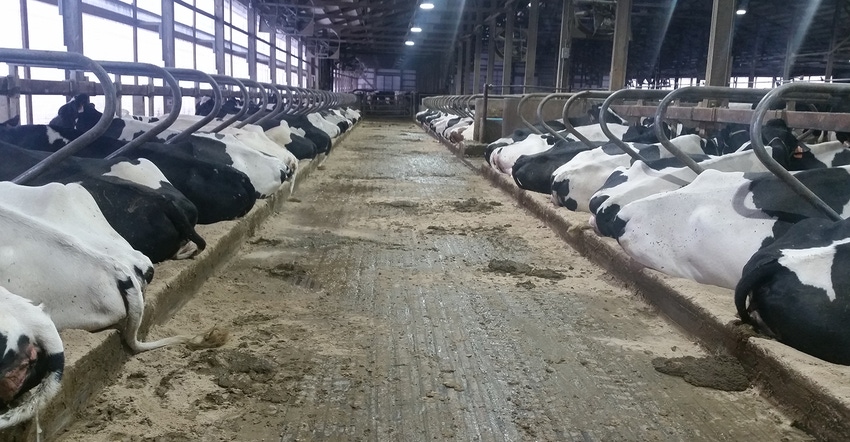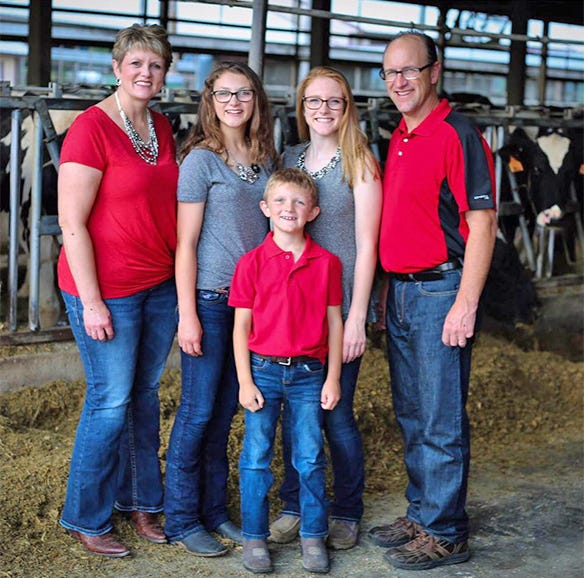August 31, 2017

More comfortable cows are producing more milk for Mitch and Jacquie Breunig at their Sauk City dairy.
“We always say at our farm we’re on a never-ending quest to get another pound of milk,” Mitch Breunig says.
The 450-cow herd has a rolling herd average of 31,500 pounds of milk. It’s been as high as 33,000 pounds, and “at any one time, there are 20-plus cows with 200,000 pounds lifetime,” Breunig says proudly.
He credits cow comfort as a major factor in the production from the registered Holstein herd — plus one Jersey brought in as a daughter’s 4-H project. The Breunigs have two daughters, Allison and Lauren, and a son, Brayden.
The comfort factor, Breunig says, has resulted in cows that are larger, healthier and longer-lived, usually through six lactations.
Greater cow comfort
The quest for greater comfort dates to The Dairyland Initiative project undertaken by Dr. Nigel Cook at University of Wisconsin’s School of Veterinary Medicine. The Breunig’s Mystic Valley Dairy became part of the study.
Breunig says he learned that as cows got older and bigger, stalls “were not built for six-lacation cows.” So for starters, he widened his freestalls.
“Cows are brilliant,” he asserts. “They have an innate ability to figure things out.” They began to lie crosswise in the wider stalls because that was more comfortable. But that also caused the stalls to begin breaking down, so several years ago Breunig widened his barn, made the stalls even wider and took out the brisket boards. The cows lay straighter and took pressure off the sides.
“If you have a barn that’s not designed for bigger cows, they’re not going to be happy,” he says, while acknowledging the debate among dairy producers that cows are getting too big. “Farmers have got to figure out what works for them.”

FAMILY FARM: The Breunig family milks 450 registered Holstein cows on their Dane County farm. From left are Jacquie, Allison, Brayden, Lauren and Mitch.

Cook notes that The Dairyland Initiative project “settled on a format that aimed to stimulate ideas rather than settle on one ‘ideal’ design concept. There is no one perfect barn; rather there are multiple barns that are perfect for individual dairies.
“The most notable contribution of The Dairyland Initiative was our science-based framework for transition cows: Provide sufficient bunk space for all cows to eat at the same time, a comfortable place to rest, sufficient space to rest without competition and limit regrouping within two to seven days before calving.” Information on the project is available on The Dairyland Initiative website. Currently, ventilation and cooling are being studied — “working on the most efficient way possible to get cows cool,” according to Breunig.
Sweating the details
To that end, Breunig installed two-piece, automatic roll-down curtains so sand doesn’t get on them, and on hot days, the curtains are rolled up. He has the roller thermostat set for 38 degrees F in cold weather, down from the initial 40 degrees F because the cows seem to be more comfortable. He also put in an automatic brush and added more fans; he watches their wind speed.
Breunig points out that he wants his cows’ udders to lie on sand bedding rather than on concrete.
“I’d rather have my cows lay and be a little dirty than stand up and be clean,” he says. Somatic cell counts consistently fall below 100,000. The cows are milked three times a day in a double-14 parallel parlor.
All that attention to comfort has made a difference in production, Breunig asserts. “We try to do a lot of little things right.” But then he adds, “We’ve got to do a lot more things.”
Because the family’s cows live longer, the Breunigs have reduced their cull rate to 20% to 25%, yielding more heifers to raise, breed and sell as fresh cows. There were 135 such sales last year, either off the farm or at Great Northern’s production sales.
“Between those two places, I have a waiting list. The No. 1 reason for cows to leave is to go live at another farm,” he says, laughing. His home-grown feed comes from 1,050 acres of alfalfa, corn, soybeans and wheat.
Breunig uses about 95% genomic sires, up from 35% just three years ago.
“I look for high genomic bulls,” he says. “I’ve really been impressed with the heifers; that convinced us to do more.” His breeding program looks for balance with high production, type and longevity.
And going forward, he says, “If I have an idea, if I’ve got a question, Dr. Cook is one of the people I contact right away.”
Breunig has been on the farm since his parents started it with 40 cows in 1961, beginning the Jenny-Lou prefix. He is a past president, and now vice president, of Professional Dairy Producers of Wisconsin and a 1992 dairy science graduate of UW-Madison. He’s also his son’s soccer coach.
Buchholz lives in Fond du Lac.
About the Author(s)
You May Also Like




